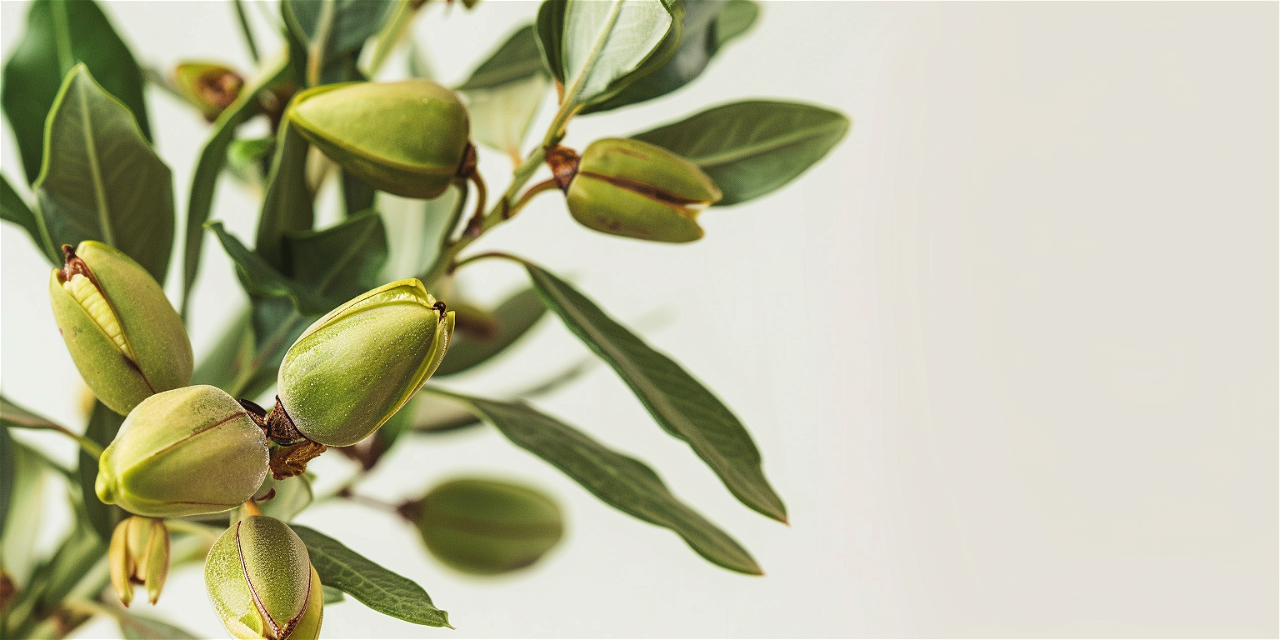
Jojoba (Simmondsia chinensis), a versatile and enduring plant, is recognized by many names including goat nut, deer nut, pignut, wild hazel, quinine nut, coffeeberry, and gray box bush. Often classified within the Simmondsiaceae family, it is sometimes placed in the Buxaceae (box family). This perennial, evergreen, dioecious, wind-pollinated shrub is native to the Sonoran Desert, encompassing southwestern Arizona, California, northern Mexico, and Baja California. In India, 90% of jojoba is grown in Rajasthan.
Morphological Characteristics
-
Height and Longevity: Jojoba plants typically reach heights of 5-6 feet, with some growing as tall as 15 feet. These resilient plants boast a remarkable lifespan of 100-200 years.
-
Flowers: Jojoba flowers are apetalous. Female flowers usually appear solitary, one per two nodes, although clusters can occur. Male flowers are clustered. Flower buds form in the leaf axils on new vegetative growth during warm seasons, remaining dormant until post-chilling. Anthesis occurs in spring when temperatures exceed 15°C, but severe water stress can inhibit flower opening. Blooming time spans from mid-March to May.
-
Fruit: The fruit is a capsule containing one to three dark brown seeds, weighing 0.5-1.1 grams and consisting of 44-56% wax. Fruits ripen in spring and early summer, with seeds falling to the ground by late summer.
-
Leaves: Jojoba leaves are xerophytic, featuring a thick cuticle and sunken stomata. These grayish-green, leathery leaves are adapted to withstand arid conditions.
Ecological and Agricultural Significance
-
Habitat: Jojoba thrives in diverse climatic, geographic, and edaphic conditions, typically on coarse, sandy, or gravelly soils with good drainage. It occupies open, sandy-to rocky flats, bajadas, and playas at elevations from 0 to 5000 feet.
-
Browse Quality: The Forest Service rates Jojoba as good to very good winter browse and fair summer browse for all livestock classes. Its foliage provides year-round nourishment for deer, javelina, bighorn sheep, and livestock. Nuts are a food source for many animals, including squirrels, rabbits, and larger birds, although only Bailey’s pocket mouse can digest the wax. In large quantities, the seed meal is toxic to many mammals, and the indigestible wax acts as a laxative in humans.
-
Historical Uses: Indigenous Native Americans in Sonora and Baja California utilized Jojoba seed and oil for cooking, hair care, and treating medical issues such as poison ivy, sores, wounds, colds, cancer, and kidney problems.
Cultivation Techniques
-
Soil and Site Selection: Jojoba prefers coarse, sandy, or gravelly soils with good drainage. Selecting a site with open, sunny conditions is crucial for optimal growth.
-
Planting: Flower buds form on new summer growth and require a specific number of chilling hours to mature. Post-chilling, buds open in response to late winter rain. Ensuring the plants experience adequate chilling and rain is vital for successful flowering and fruiting.
-
Water Management: Jojoba is drought-tolerant but needs sufficient water during the flowering and fruiting periods. Severe water stress can prevent flower opening. Regular watering during dry periods can enhance growth and yield.
-
Climate: Jojoba plants are adapted to the warm temperatures of the Sonoran Desert. Flowering occurs in spring when soil and air temperatures rise above 15°C.
-
Propagation: Jojoba can be propagated from seeds or cuttings. Seeds are sown directly into the soil or started in nurseries before transplanting. Cuttings from mature plants can also be used to produce new plants.
-
Harvesting: Fruits ripen in spring and early summer, with seeds falling to the ground by late summer. Harvesting can be done manually by collecting seeds from the ground or shaking the plants to release the seeds.
Challenges and Solutions
-
Pests and Diseases: Jojoba is relatively resistant to pests and diseases. However, monitoring for any signs of stress or damage is essential. Implementing integrated pest management strategies can help maintain plant health.
-
Climate Adaptation: While Jojoba is suited to arid and semi-arid conditions, extreme climatic events such as prolonged drought or unseasonal rains can affect growth. Developing irrigation systems and protective measures can mitigate these risks.
Economic and Environmental Benefits
-
Market Potential: Jojoba oil is highly valued in the cosmetic and pharmaceutical industries for its moisturizing and healing properties. Establishing a Jojoba plantation can be economically beneficial for farmers in suitable regions.
-
Environmental Impact: Jojoba cultivation can contribute to land restoration and erosion control in arid regions. Its deep root system stabilizes the soil and conserves water, making it an environmentally sustainable crop.
















